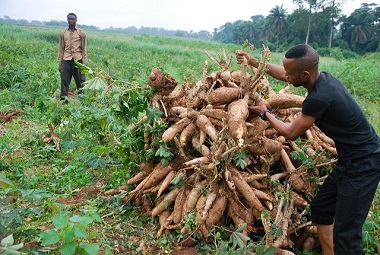This week, the Food and Agriculture Organization of the United Nations (FAO) hosted an International Symposium on The Role of Agricultural Biotechnologies in Sustainable Food Systems and Nutrition at its headquarters in Rome. It has all the trappings and gravitas of a UN meeting: member-nation delegates, placards bearing their countries’ names, earphones streaming simultaneous translations of speakers’ presentations, a backdrop of flags from FAO’s 194 members, and the grand entrance of José Graziano da Silva, FAO’s Director-General, to address the opening plenary.
This symposium brings together global expertise on the potential for biotechnology to eradicate hunger and malnutrition and promote sustainable agriculture. But from the opening remarks, it was clear that semantics and sensitivities were as much a topic of discussion as science and technology. The preferred wording at this symposium is the plural, not the singular, form of the word—“biotechnologies.” It was an effort to focus our attention on a broad range of agricultural biotechnologies. That term covers relatively simple applications such as fermentation processes, bio-fertilizers, artificial insemination, vaccine production, disease diagnostics, biopesticides, and marker assisted selection in crop breeding.
It also includes more complex applications such as genome editing and synthetic biology, both of which garnered mention from Louise Fresco, president of the Executive Board of Wageningen UR, the Netherlands’ powerhouse of teaching and research in agriculture and the life sciences.
And yes, it also includes genetically modified organisms (GMOs) which FAO clearly explained should not be equated with biotechnology. Rather, they established GMOs as one set of biotechnologies among many, many others.
That did not stop the plenary and parallel sessions from tackling the issues on everyone’s mind—what will come of GMOs in food and agriculture? Gebisa Ejeta, World Food Prize laureate, noted sorghum breeder and distinguished professor at Purdue University, made the opening salvo, calling for more science-based assessment of the opportunities posed by GMOs and other technologies for developing-country agriculture. Julie Borlaug, associate director of the Norman Borlaug Institute for International Agriculture at Texas A&M University, was even more pointed in her remarks: during a side event organized by Croplife International, she took aim at the anti-science community’s efforts to close down dialogue on technologies for small-scale, resource-poor farmers throughout the developing world, invoking the legacy of her grandfather, Nobel Prize Laureate Norman Borlaug.
Despite the controversy, many of us settled into a tentative but comfortable consensus: one cannot simply dismiss a technology out of hand, and no technology offers a complete solution. A really big toolbox is needed to enhance the productivity and sustainability of intensive agricultural systems and improve the welfare of the poor.
Six parallel sessions brought this into stark relief with thought-provoking presentations on biotechnologies that spanned scientific advances well beyond genetically modified traits and crops. Genomics for forest tree improvement, molecular breeding for Bambara groundnuts (a cousin of the humble peanut), diagnostic tools for detecting diseases in aquatic species, fermentation technologies for livestock feed, biofortified sorghum, and so much more.
Who knew that there were so many exciting biotechnologies out there?
Of course, there is always that question in the back of my mind—are any of these technologies viable? Will they benefit smallholders in developing countries? Will smallholders adopt them? Will they help improve farm incomes or household welfare? Will they lower food prices for poor consumers? My colleague Nicola Cenacchi provided some perspective on this with a forward-looking analysis of the economic impact of 11 different technologies highlighted in a recently published IFPRI piece titled Food Security in a World of Natural Resource Scarcity: The Role of Agricultural Technologies and work undertaken by the CGIAR’s Global Futures and Strategic Foresight program, led by IFPRI.
I offered a review of the evidence from both ex post and ex ante impact assessments (summarized here), opening the door to three sessions on public policy and human dimensions of biotechnologies. (Full disclosure: I served as a member of the Symposium’s Advisory Panel and offered the FAO Task Force that organized the symposium with recommendations on both the form and content of these sessions). These sessions led to heated but largely evidence-based discussions around public R&D priorities, scientific and innovative capabilities in developing countries, intellectual property rights regimes, entrepreneurship in the life sciences, and biosafety regulation.
And this is where I most appreciate FAO’s effort to distract us from GMOs. There was little value created by speakers repeating discredited critiques of GM technologies, particularly the poorly evidenced criticisms of Bt cotton in India that remain the go-to storyline for populists and anti-GMO advocates. Rather than get bogged down in those tired conversation and throw out potentially useful options for scientists and farmers, we need to think more about the policy, regulatory and investment strategies that enable the development of near-horizon technologies to end hunger and malnutrition. This includes technologies such as cisgenesis and genome editing, which garnered notable mention at the symposium.
I came away from the symposium with this final thought. Today, agricultural science faces opportunity and criticism of equal proportion. The way forward requires continued investment in scientific inquiry and R&D on biotechnology tools and products; relevant and rigorous assessment of their impact on productivity, sustainability and human welfare; and keenly informed debate on the cultural, political, and ethical role of science in society.







